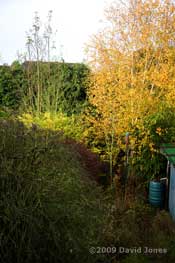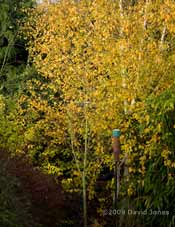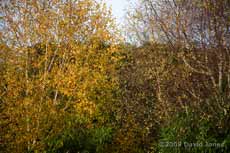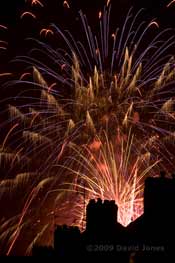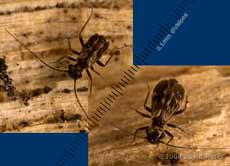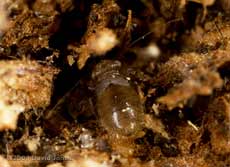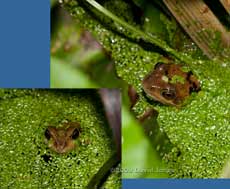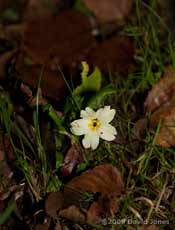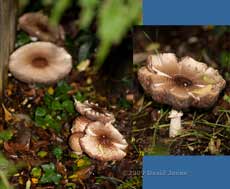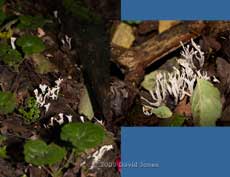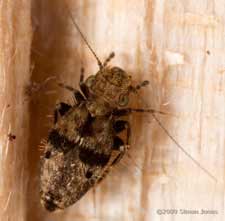Go to the last entry on this page .....Go to previous entry3 November - After a fantastic weekend, full of high emotion as one of our three sons got married to a wonderful bride, it is going to take quite a while to wind down again. And it was also a time to be proud of not just the groom, but of all three of our sons who were a credit to us, our eldest son's fantastic partner, and not forgetting of course their beautiful little daughter who made lots of friends amongst the guests during that couple of days. I hope to get going with the diary again in the next couple of days. In the meantime, rostocki continues to thrive on its log, and November has started with some wet and blustery weather, after an unusually mild October.
16 November - What a frustrating couple of weeks! It has been a struggle to keep awake enough to do much of anything, let alone take photographs and keep the diary going. I'm not much more alert today, but at least here's a bit of an update... After the drastic change in the weather that took place the day after our son's wedding, the first half of November has remained cool, with daytime temperatures ranging from 8 - 14C, and it dropping to between 3 - 10C at night. On the 14th we had a really windy day, enough for me to secure the guy ropes to the caravan shelter, although it turned out to be less dramatic than the forecast suggested.
The day before that, I took several pictures to record the change in colour of the Birch tree since I last posted a picture of it on 21 October. In that three week period, few leaves had fallen from it, but its green colour had completely gone, replaced by this golden hue which really shone in the sunlight
In a complete contrast, over the same period the Rowan (just in front of the Birch) has completely lost its red foliage.
And once again it is interesting to compare our Birch with next door's Silver Birch. Over those three weeks the Silver Birch had lost most of its leaves, and was almost bare.
I had expected the weekend winds to have completed the task of stripping the leaves of both Birches, but it looks as though a couple more windy days, which are forecast for this week, will be needed to complete that task. After a dry October the first half of November has been quite showery. Bonfire Night (the 5th) was a washout but the local public display in Manor Park on the Saturday that followed had more luck. As dusk fell the skies were almost cloudless, and I just had to get out my tall Benbo tripod to capture some of the action. One drawback of having a healthy Birch tree is that I no longer have the excellent vantage point available down the West Wing, so I set myself up nearer the house.
Unfortunately, I'm sure there weren't as many high sky-bursts as in the past, and there seemed to be less variation in those that did rise above the rooftops. So there are only a few pictures this year.
In the garden everything looks rather soggy and sad right now. There are still fungi popping up. In fact I don't think I've seen this many here about for a long time. If I can get my act together I shall add some more photographs over the next day or so. The bird feeders are busy every day with the regulars, mainly Sparrows and Goldfinches, with Great and Blue Tits next, and the occasional Robin and Dunnock. Strangely, I'm still not seeing a Blackbird at the house end of the garden, although they are definitely present at the bottom of the garden. And no 'different' Winter visitors as yet. I don't intend to bore you with a long list of observations of my 'pet' barkfly, the P.rostocki that I've been monitoring since the beginning of October. However, I'm pleased to say that it continues to thrive. Over the last week it has switched from (usually) two to just one feed a day, always on or around the same Lichen thallus, and for the rest of the time it remains in its shelter apart from one or two short trips out to defecate. And over the last month I don't think its has disappeared from the camera's view for a total of more than a minute or two. A bit of cheery news concerning rostocki - One of my recent pictures is to be included in a Swedish encyclopedia. There are other barkflies on the log, and nymphs are regular visitors to the lichen. However, I haven't seen the carnivorous mite for the last few weeks. With the log burner now in regular use, the log store is having to give up its stock of seasoned wood. Each time I go down there to replenish the stack on the veranda, its a case of checking for barkflies.
I really need to spend time checking the older logs more carefully. The individuals I'm finding at the moment vary in size quite a bit, and all have brachypterous wings (shorter than the abdomen), as can be seen in this pair, photographed at the same scale.
The only other species I've come across in the log store so far this month has been this Lepinotus patruelis, found on a well seasoned bit of oak.
When the next combination of dry day and me finding that the force is with me, I must head up to my son's house to collect a Discovery full of fresh (seasoned) supplies.
23 November - We've been getting some really blustery weather recently, and everything out the garden is rather soggy, but it has been mild. Since the start of the month only twice have the overnight temperatures dipped below 5C in the garden. Most nights have remained nearer 9C, and last night it remained above 11C before a high of 13C today. The winds have completed the task of denuding our Birch tree, but there are still some of the smaller leaves on our neighbour's Silver Birch. In the last entry I mentioned that the Blackbirds were keeping to the far end of the garden. Well, yesterday I saw a very nervous individual visit the Hawthorn, and today a female spent a short time feeding on the ground right next to the veranda, so it looks as though they are back! Also I saw (and heard) a Coal Tit for the first time for a while, and while I was down at the log store a rather magnificent female Sparrowhawk attempted to snatch lunch. It made two attempts, perching in between on the caravan shelter, before leaving to hunt elsewhere. I'm still waiting for the weariness to ease up. I would like to spend a bit of time starting to tidy up parts of the big pond, which has become rather overgrown in the continuing mild and wet conditions.
The frogs certainly seem to be enjoying the weather. I hear them croaking every day, although when I went out with a torch tonight I was only able to spot these two individuals amongst the vegetation.
While the garden is now looking rather sorry for itself, at the far end of the big pond there is a promise for the future in the form of this solitary Primrose flower which has opened up amongst the fallen Birch leaves.
At the moment, the most prominent fungi are these Shaggy Parasols (Lepiota rhacodes) which have been popping up between the Hawthorn and the veranda over the last month.
Just the other side of the Hawthorn a very different fungus stands out against the colour of the decaying logs from which they have developed. This is Stag's Horn, or Candle-snuff Fungus (Xylaria hypoxylon).
Returning to the subject of barkflies, this is a Pteroxanium kellogi, an uncommon species that turns up in the log pile from time to time. This was one of two that I found on logs last week in timber stored from last year. Just a note to explain the different copyright sign - the picture was taken by my newly married son, using my macro lens on his new camera (Canon 5D Mk2). I've also come across several more Lepinotus patruelis on the older (and very dry) logs, as well as the more usual Peripsocus milleri.
Finally, a mention of P.rostocki. The individual that I'm monitoring continues to reside in its shelter, leaving just to feed and defecate. Yesterday it deviated from its usual routine and fed twice, at around 8am and then again at 11.40am. It seemed that something disturbed its first feed as it stayed out for less than half an hour (usually feeds take at least 45 minutes). Today there was an even more drastic variation. It left the shelter at 3.17am, and disappeared from the image (the camera was covering just the area around the shelter as I tried to capture the process of defecation). It hadn't returned when we got up, so I went outside and panned the camera back to cover a larger area. I was relieved to spot it feeding on the 'usual' lichen. While I watched, it finished the meal and wandered off. However, instead of heading 'home' it meandered around as though lost. Eventually it found itself back at the Lichen. As soon as that happened, it seemed to pick up the trail back to the shelter and was back inside within a minute. One problem with photograph (still or video) at this range is the very shallow depth of field. The lens on the cctv camera has to be focused manually so I have to guess the best position when I try to capture events like the barkfly defecating. In this case everything seemed to be right until she lifted her rear end higher than I had anticipated, and I had to dash outside to adjust the lens by a small fraction of a millimetre. I made it just in time as she projected the pellet out of frame! The lower images show consecutive frames in the sequence. At the right of the three pictures you can see a similar, spherical pellet that was projected by her two days ago, but which was 'captured' by a strand of silk. That is the only pellet produced by her that I can see in the area around the shelter. And I managed to collect a Discovery full of logs last week. Most of them are still under a tarpaulin, waiting for me to transfer them to the log store
25 November - A bright day with long periods of sunshine and the occasional shower, and what appears to be an abrupt end to my monitoring of rostocki. As I mentioned in the last entry, two days ago the barkfly had changed its behaviour pattern, staying away from the shelter for a much longer period than at any time since the beginning of October. Yesterday, she appeared to return to a more familiar pattern, with a feeding session lasting some 45 minutes later. She didn't visit the lichen but chose to graze on algae to the right of the shelter. At around 10pm barkfly nymphs started grazing in the area below the shelter. This activity continued all through the night, with at least eight nymphs in the group, and occasionally one would approach within millimetres of the shelter. At 7.29am rostocki suddenly left the shelter and headed up out of the image frame. When I first checked the image at 9am she had still not returned. Five minutes later I spotted it grazing on algae some way to the right of the shelter. Soon afterwards she headed down, passing to the right of the lichen. The camera recorded her briefly just one more time as she headed back up and off further to the right. This time she went towards an area of the log which is covered with lichen similar in type to the one she has fed on since I started watching her. She had not returned to the shelter by this afternoon and I have spent a couple of hours searching for her in vain. While its disappearance is a bit disappointing, I'm not really surprised. The solitary lichen is looking rather worst for wear, and I had wondered how long it would be before she needed to find a 'fresh one'. I will be checking the log again over the days to come, but with so many hiding places available, coupled with her tendency not to wander far, It's going to be a real game of hide and seek! If she doesn't re-appear then I will be probably set up the camera to monitor another barkfly species. Click on images to see larger version |
|
